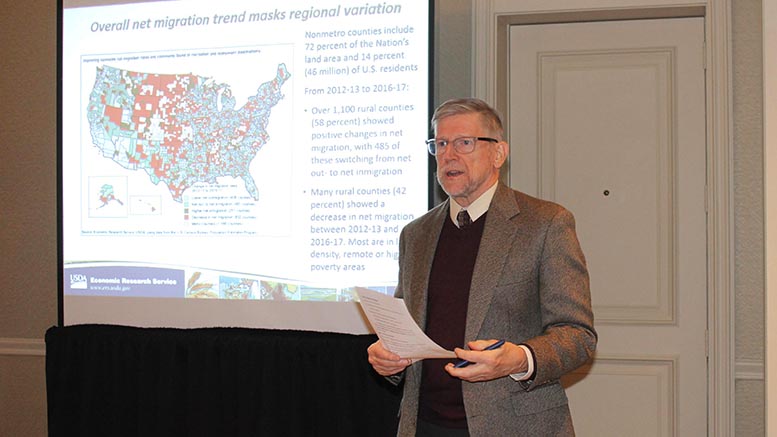A new commission at the American Association of Community Colleges (AACC) is focusing on what it means to be a small and rural college in America today.
The AACC Commission on Small and Rural Colleges’ discussions this week at the association’s fall meeting in Arlington, Virginia, ranged from the macro to the micro, such as how the colleges fit into the social and economic development of rural America, to local fundraising.
The commissioners heard from federal researchers, who noted that population changes in rural America present challenges and opportunities for community colleges.
While most rural areas have experienced a population decrease in recent years, community colleges can play a role in attracting more people and creating new economic opportunities, they said.
A growing share of rural adults age 25 and older have associate degrees as their highest level of educational attainment, said Alex Marré, a research economist with the Rural Economy Branch of the U.S. Department of Agriculture’s (USDA) Economic Research Service. The number of people in that category increased from 6 percent to 9 percent between 2000 and 2015.
According to 2015 data, median earnings for rural adults with associate degrees is roughly $31,000, Marré said, compared to $35,000 in urban areas.
Nationwide, the rural population is beginning to increase a bit, following six straight years of population loss, said John Cromartie, a geographer with the Resource and Rural Economics Division at USDA. That is due to net migration, particularly in areas that are magnets for recreation and retirees, he said. High-poverty areas, such as Appalachia, however, are continuing to see a shrinking population.
“Natural change” in population is continuing a long-term decline, as there are more deaths than births in rural areas. That’s attributed to both an aging population and increased mortality rates, Cromartie said.
The workforce challenge
While employment trends in metropolitan areas have seen a big improvement, Cromartie said, labor force participation in rural areas is only growing about 0.5 percent a year since 2010, which is not up to pre-recession levels.
While the deepest outmigration from rural America resulted from the farm crisis of the mid-1980s, Cromartie said, there’s been a small in-migration in the 1990s during the dot-com bubble when tech workers realized they could work anywhere and sought the quality of life and scenic amenities in certain rural areas.

Joseph Schaffer, president of Laramie County Community College (Wyoming) and chair of the new AACC commission, leads the group’s discussion, which covered an array of topics. In the photo with him is commissioner member Kristin Westover, president of Mountain Empire Community College (Virginia).
John Rainone, president of Dabney S. Lancaster Community College in Virginia, said his community has a new call center and created a “drone zone” to attract businesses, but local people “don’t think it’s a real job unless it’s manufacturing. We have to change people’s attitude.”
Several of the college leaders noted that, even though it’s important to recruit new employees to their service area, often helping businesses already in the community can create more jobs. Rainone said a new manufacturer to his area brought about 35 new jobs, while helping 10 to 15 small companies already in the community expand their businesses yielded 60 to 75 new jobs.
But members of the commission noted that even with the training they provide, local employers still can’t find enough workers to fill available jobs. Some noted that companies often don’t provide high enough wages to attract people to those jobs. Also, in rural areas there remains some resistance to the benefits of a higher education, and whether it’s needed to secure a job, they said.
In addition, often the students who do enter a training program leave for a job before completing their program — and sometimes they leave the area. For some presidents that’s OK, arguing that they’re helping students attain the skills to get good jobs and better themselves, even if they move away.
But for others, such as Michael Chipps, president of Northeast Community College in Nebraska, it’s important that colleges do what they can to keep those workers in the community, which can vanish without them. Chipps highlighted how many rural communities depend on their community colleges, which serve as the education, cultural and social hubs of small towns.
“We are an oasis in rural America,” Chipps said.
Often under-appreciated
Still, rural community colleges often are under-appreciated, especially by the country at large, several commissioners said. Some communities balk at career and technical education (CTE), which may prompt rural colleges to focus more on liberal arts programming and become more like their predecessors, the junior colleges. It can make financial sense, too, as many of the technical and health care programs such as nursing are expensive to run and often draw few students.
“Many states have walked away from CTE,” said Ryan Carstens, president of Eastern New Mexico University-Ruidoso.
In fact, state funding is frequently directed to those going for bachelor’s and master’s degrees, he said. And because of state funding cuts for K-12 education and the rise of dual-enrollment programs, states like New Mexico are “depending on community colleges to educate high school seniors. We’re becoming the last years of high school.”
A growing number of all community colleges are relying on dual-enrollment of high school students to steady dropping enrollment. One college president said that 48 percent of his college’s enrollment comes from dual enrollment. But local four-year institutions also are struggling with enrollment, and more of them are now offering dual-enrollment programs, too.
The commission also discussed mental health and behavioral issues among students, and opioid addiction facing rural colleges, which are challenged to find the resources to address those issues. Colleges often have to share resources or partner with local health-care provide for such services.

